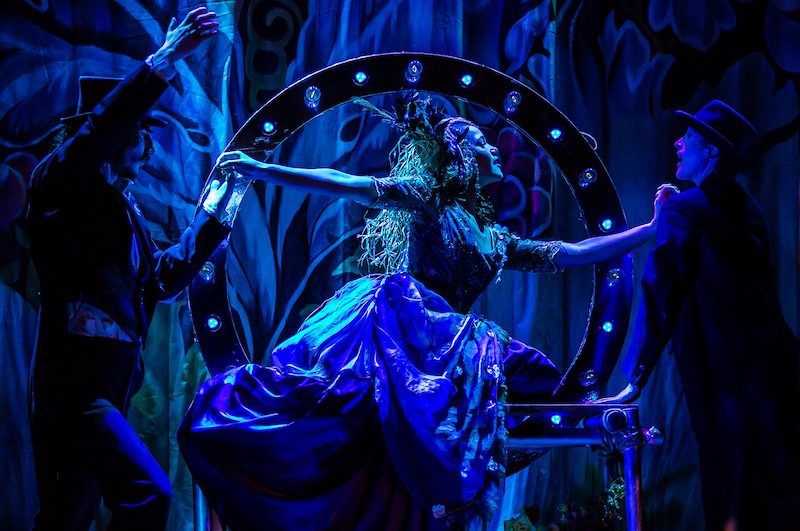Shakespeare can be drier than unbuttered toast, all but impenetrable to younger audiences.
Dense text, packed with nigh-incomprehensible speech patterns from 400 years ago and an over reliance on cross-dressing gags with a far shorter shelf-life (I’m looking at you, Twelfth Night) frequently leads me to (a) fall asleep, (b) rewatch fantasy classic “The Dark Crystal” in my head, or (c) lose my attention to a packet of sweets.
It was with some trepidation, then, that I sallied forth (Shakespeare-appreciating friend in tow) to The Watermill Theatre to see their production of “A Midsummer Night’s Dream”, fresh off the back of a national tour and several centuries of being “that” play we all had to study at school.
Did it magically beguile my senses? Or did I succumb to the mystical allure of my fruit pastels?

Baz Luhrman’s “Romeo and Juliet” revolutionized Shakespeare, proving to audiences and creatives that you didn’t have to wear tights and a ruff to recite rhyming couplets – they could in fact sound sexy if they were spoken in situations we could relate to and/or set to music that wasn’t played on a lute.
Director Paul Hart beats Baz at his own game – this is the “Midsummer” the script’s always deserved, for while the lines remain the same, everything else has been brought dancing into the 21stcentury.
So while the plot still revolves around ancient Athens, the action all takes place within a disused theatre, the production slowly unfurling as if from the imagination of the be-suited sprites who flick and flitter amongst the ropes and brooms – an effect that’s deepened by Puck (Molly Chesworth)’s magician-like appearance, complete with stunning spells and illusions. Is everything that follows true, or another of her tricks?

This combines to make “A Midsummer Night’s Dream” actually feel like a A Midsummer Night’s Dream – a great fit for our modern era (for do we not question the truth of all we see and read?) and a framing device which makes it far easier to swallow the 4 surreal plot lines about donkey’s heads and why in the name of God anyone would fancy Demetrius.
Likewise, the bold decision to have every actor in the cast play a modern instrument at various points throughout the story injects life and passion into what could otherwise be a twee English pastoral – nowhere evidenced to greater effect than by the moment when magic dust is sprinkled over a sleeping Titania during a stomping rendition of “I Put A Spell On You”. It sounds obvious, but it’s so much easier to get caught up in the plot when you have witty and familiar song choices to pull you in.
All too often, modern re-imaginings of Shakespeare amount to tacked-on new age music or a gender switch. I can make no greater compliment than to say that in this case, the additions felt so natural that you can almost imagine Shakespeare had them in mind in the 1590s, and so magical that they evoked Dumbledore’s words from “Harry Potter” – “Ahh, music! A magic beyond all we do here!”

With such magical material in the plot, the acting has a lot riding on it. It puts me in mind of Emilia Clarke; none of us believe in dragons, and yet we sobbed along with Danearys when her winged steed Viserion was killed in “Game of Thrones” (or maybe that was just me). Why? Because Emilia Clarke is a phenomenal actress, and she made us believe in her pain.
This is the gift, and curse, of acting – the entire life of the text, its meaning and the emotions it seeks to induce, are entirely reliant on your abilities, as an actor, to bring that text to life. Imagine the extent to which this burden is intensified when the text is packed with “thine”, rhyming couplets, and plot intricacies you can entirely miss if you get distracted by your fruit pastels for more than 3 seconds.
Thank Falstaff then that The Watermill Ensemble is stuffed to the gills with superb actors and actresses. For their lines are not just spoken, but painted by their entire bodies to the extent that you could watch this performed silently and still understand what was going on – you don’t have to strain to work out the intricacies of the plot when they’re so clear and compelling.

I can think of no greater way to prove this, and to convince you to see the show, than by saying that the whole “Pyramus & Thisbe” play within a play is actually funny in this version, rather than just being that horrific moment when you realize that the play isn’t actually over at the point when everyone wakes up and stops being donkeys.
It’s unfair to single a few cast members out for praise – everyone in this production is the equal of anyone I’ve seen on stage or screen – but standing ovations are absolutely due to those who portrayed Peter Quince and his players (particularly Victoria Blunt’s Bottom) for wringing tears of laughter out of a Shakespeare-skeptic’s heart. You will do yourself a disservice if you miss the opportunity to see them.
“A Midsummer Night’s Dream” runs at The Watermill Theatre in Newbury (RG20 8AE) from the 19th February – 7th March, with tickets available at the box office on 01635 46044 and www.watermill.org.uk.
With thanks to Daryl Penny for his observations & fruit pastels.

















































